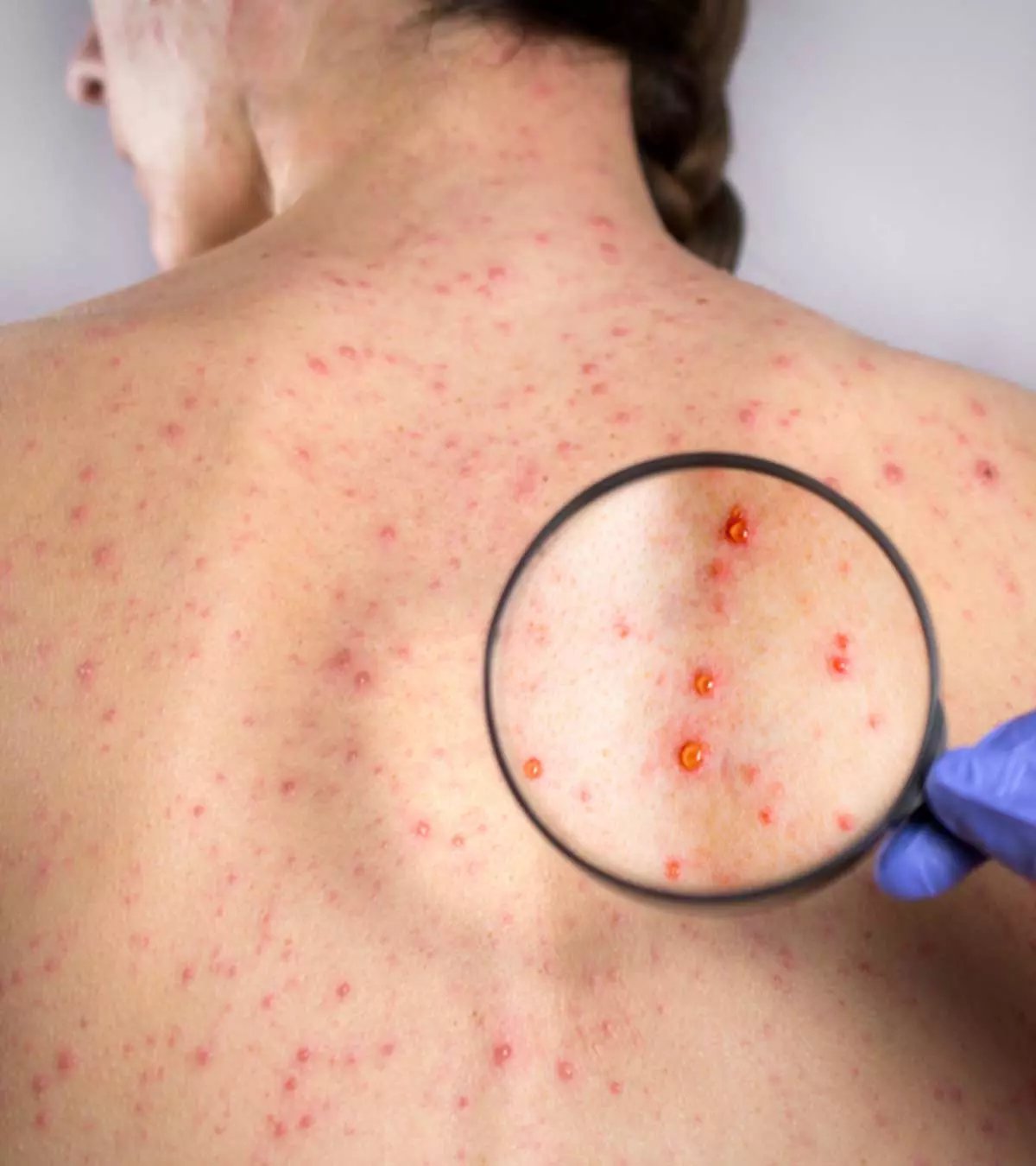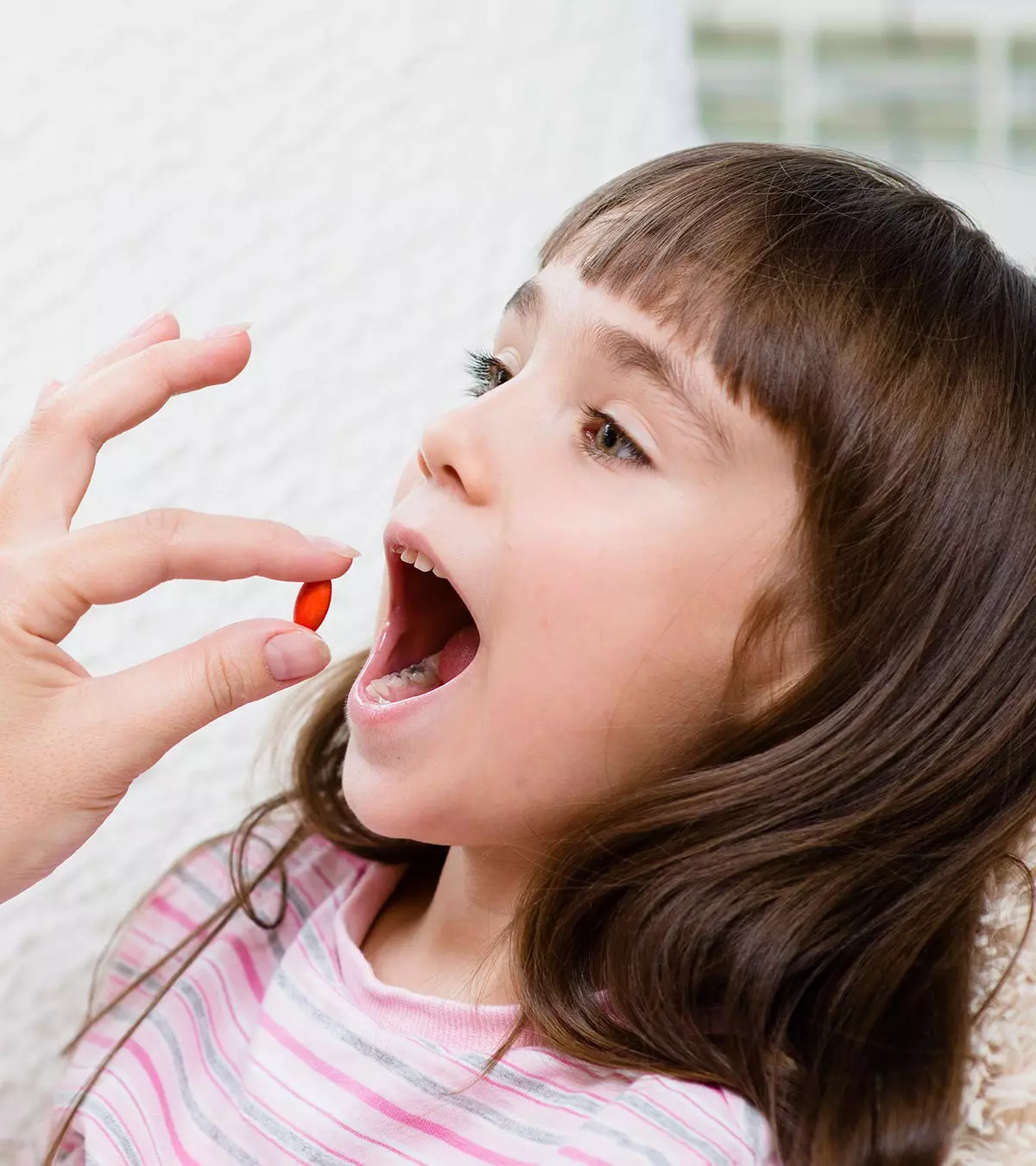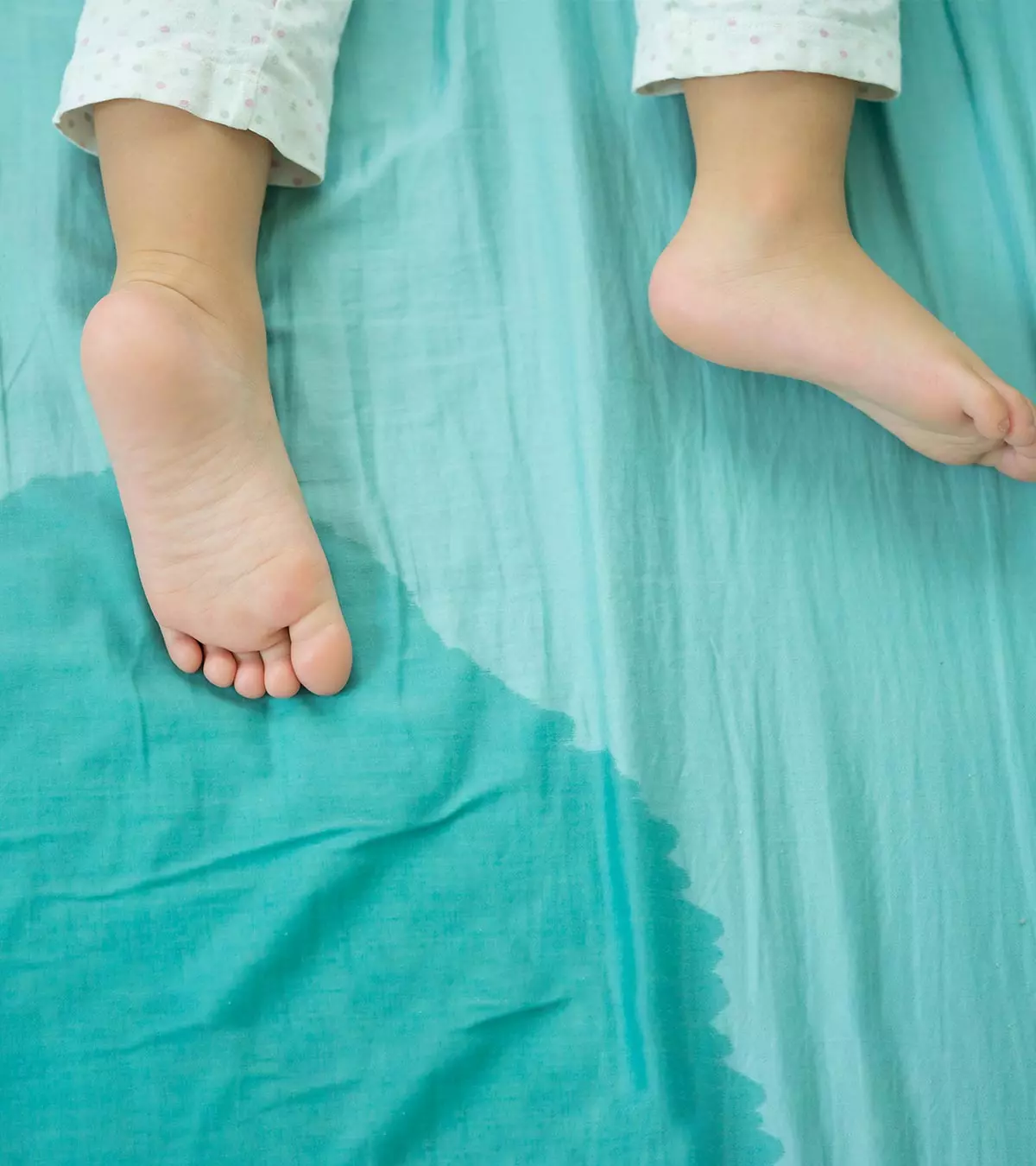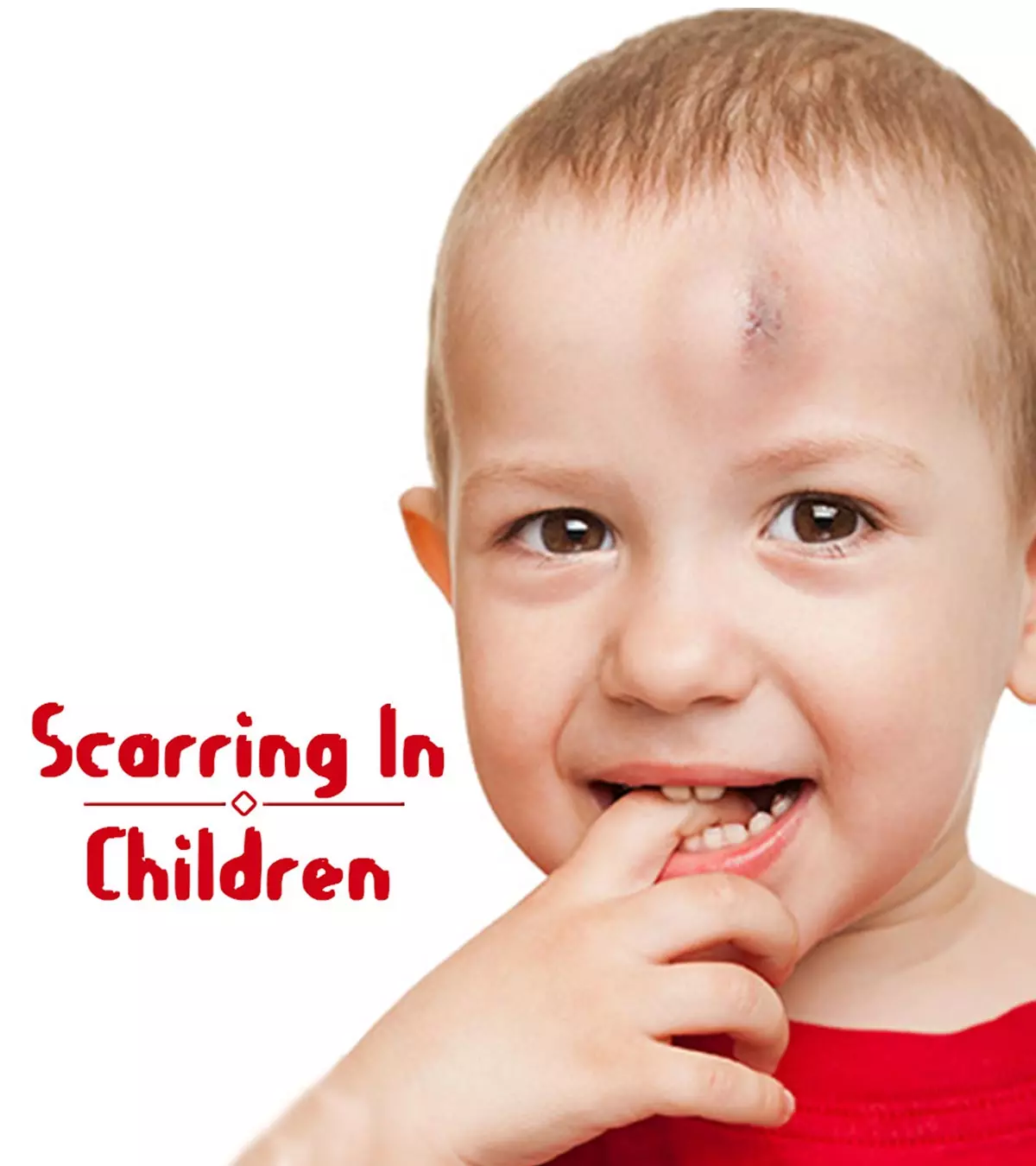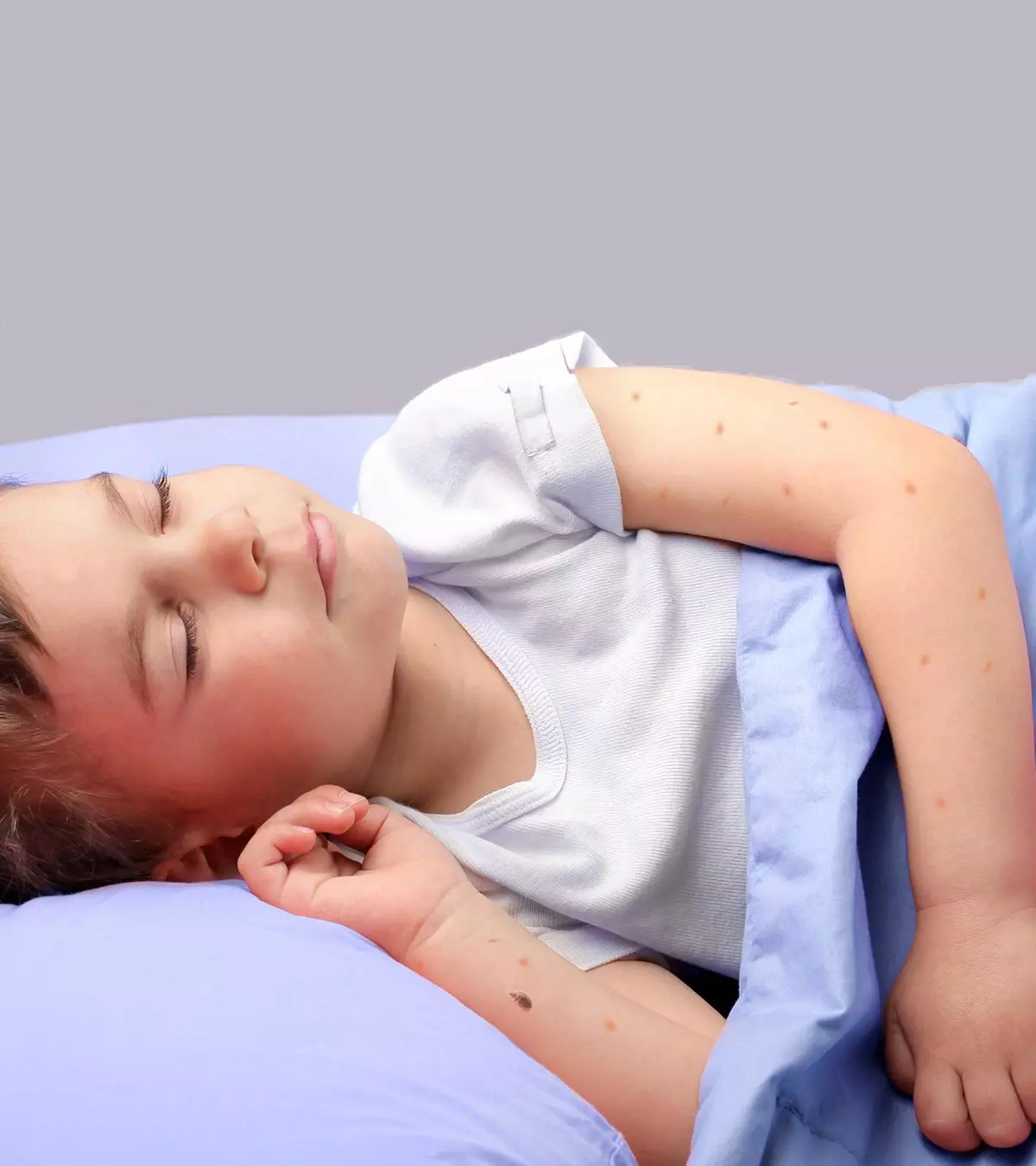
Image: Shutterstock
Genetic disorders in children are mild to severe health problems, which occur when a gene (or genes) fails to express itself properly. This may result from a change in the gene, shifting of a gene from one chromosome to another, a missing or extra chromosome, an insufficient or extra sex chromosome, or when a part of a chromosome is missing (1).

Generally, a child can inherit a genetic disorder from parents or develop it when born with one or more altered genes (congenital genetic mutation). Data shows that approximately six out of ten people will have a health condition caused by specific genetic issues (2).
Learn about different types of genetic disorders, their causes, symptoms, diagnosis, and treatment in children.
Key Pointers
- Down syndrome is the most prevalent genetic disease among children in the US and is caused by an extra chromosome 21.
- Most cases of cystic fibrosis are detected during neonatal screening, followed by additional sweat tests or genetic testing.
- Thalassemia is a blood condition caused by a genetic mutation that impairs hemoglobin production.
- Sickle cell anemia is a hereditary condition that changes the shape of red blood cells.
Types Of Genetic Disorders
Genetic disorders can be classified as follows (33):
- Chromosomal: These occur due to a structural or numerical problem in one or more chromosomes. Individuals may have missing or duplicated chromosome material with this type.
- Complex (multifactorial): These conditions arise from a mix of gene mutations along with other influences, such as exposure to chemicals, diet, medications, or the use of tobacco and alcohol.
- Single-gene (monogenic): This category includes disorders resulting from a mutation in a single gene.
Common Genetic Disorders In Children
Down syndrome
Down syndrome is also called Trisomy 21 because children with this syndrome have an extra copy of the 21st chromosome. This affects the child’s development and causes mental and physical challenges. Down syndrome is the most common chromosomal condition in the US: it occurs in around one in every 700 children (3).
Causes and risk factors of Down syndrome
The extra chromosome 21 causes Down syndrome in children; however, researchers are unsure what causes the extra chromosome. It is believed that the mother’s age might increase the risk of Down syndrome. A woman above 35 is at a greater risk of having a baby with Down syndrome. However, some women below 35 also have babies with Down syndrome (3).
Signs of Down syndrome

Some common physical features of Down syndrome in babies and children are (4) (3):
- Flattened face and nose
- Short neck with extra skin at the back
- Poor muscle tone
- Loose joints
- Almond-shaped, upslanting eyes
- Small head, ears, and mouth
- Irises on eyes have white spots
- Short height
- Small hands and feet
- Short fingers
- A groove between the first and second toes
- Slow physical growth
- Delay in reaching milestones
- Heart problems
Common cognitive and behavioral challenges that children with Down syndrome experience are (4):
- Short attention span
- Learning difficulties
- Delay in language and speech development
- Impulsive behavior
- Inability to judge
Diagnosis of Down syndrome
The diagnosis of Down syndrome includes prenatal screening and prenatal diagnostic testing (3) (5).
- Prenatal screening tests: These tests indicate the likelihood of a fetus having Down syndrome; however, these tests do not confirm the presence of the disease.
- Blood test and ultrasound (in the first trimester)
- Blood test (in the second trimester)
- Both blood test and ultrasound (in the first and second trimesters)
- Prenatal diagnostic tests: If the screening tests give positive results, they are confirmed with the help of the following diagnostic tests.
- Chorionic villus sampling (examines cells from the placenta)
- Amniocentesis (examines the amniotic fluid)
- Percutaneous umbilical blood sampling (examines blood from the umbilical cord)
Many of these tests are associated with an increased risk of miscarriage.
Treatment for Down syndrome
Early intervention programs (programs and therapies provided to children from a young age) may help children with Down syndrome deal with their condition more efficiently and reach their full potential. Some therapies that help children with Down syndrome are (6):
- Physical therapy (activities to develop motor skills and muscle strength)
- Speech and language therapy (activities to improve communication skills)
- Occupational therapy (skills to perform their everyday tasks efficiently)
 Be watchful
Be watchfulFragile X syndrome
Fragile X syndrome is a genetic disorder that affects males with more severity than females. According to the research, one in 7,000 males and one in 11,000 females are diagnosed with this condition.
Cause of Fragile X syndrome
Fragile X syndrome happens when there is a mutation (change in the gene structure) in a gene (FMR1 gene) located on the X chromosome. This gene makes a protein called FMRP, which is required for brain development. However, due to the mutation, this protein is not formed in a child having this condition (7).
Symptoms of Fragile X syndrome
This disorder causes developmental delays in children, learning disabilities, and social and behavioral challenges.
Some symptoms of Fragile X syndrome in children are (7):
- Inability to sit, walk or talk at the correct age
- Difficulty in learning new skills
- Inability to make eye contact
- Being hyperactive
- Inability to pay attention
- Speaking or acting without thinking
- Male children have intellectual disabilities, while females have normal intelligence or slightly less intellectual abilities.
The risk of autism spectrum disorder increases in children with Fragile X syndrome.
Diagnosis of Fragile X syndrome
Fragile X syndrome is diagnosed with the help of a blood test. The test also detects the changes in the FMR1 genes that cause the condition (7).
Treatment for Fragile X syndrome
- There is no cure for Fragile X syndrome; however, therapies help children learn basic skills like talking, walking, or communicating with others.
- Medicines are advised to control behavioral problems.
- Healthcare providers, parents, teachers, therapists, coaches, and childcare providers should come together and develop an effective plan to help the child (7).
Cystic fibrosis
Cystic fibrosis is a genetic disease that affects children’s respiratory, reproductive, endocrine, and digestive systems
. Around 30,000 people in the US and 70,000 people worldwide are affected by this condition (8).
Causes of cystic fibrosis
Cystic fibrosis is caused by the mutation in the gene responsible for making cystic fibrosis transmembrane regulator (CFTR) proteiniA protein that regulates salt and water balance in the several cell surfaces (including lungs), a defect in which causes lung disorders . If children inherit two copies of the defective gene (one from each parent), they express the symptoms of cystic fibrosis; otherwise, they remain a carrier for cystic fibrosis.
The defective gene is responsible for making thick and sticky mucus that hinders the body’s normal functioning.
The mucus
- clogs the lungs, causing infections.
- Blocks the pancreas, hindering its normal functions and production of insuliniA pancreatic hormone which plays a key role in regulating the blood sugar levels in the blood .
- affects normal bowel function, causing constipation or loose stools.
- clogs the male reproductive system, making males sterile (8).
Symptoms of Cystic fibrosis
In some children, the symptoms of cystic fibrosis are seen right after birth, but in others, they may be seen later.
Some common symptoms are (8) (9):
- Lung infections, cough, and wheezing
- Shortness of breath
- Frequent bowel movement
- Bulky, greasy, and foul-smelling stools
- Salty sweat
- Poor growth in height
- Less weight gain
- Some children may have nasal polyps (tissue growth inside the nose), sinus problems, and fatigue.
Diagnosis of Cystic fibrosis
Cystic fibrosis is diagnosed by newborn screening in most children. If the test results are positive, these children undergo a sweat test or genetic testing.
A sweat test is the most common painless diagnostic test for cystic fibrosis. In this test, a small electrode is placed on the child’s arm, and sweat is collected to measure the amount of chloride. If the level of chloride is high, the child has cystic fibrosis.
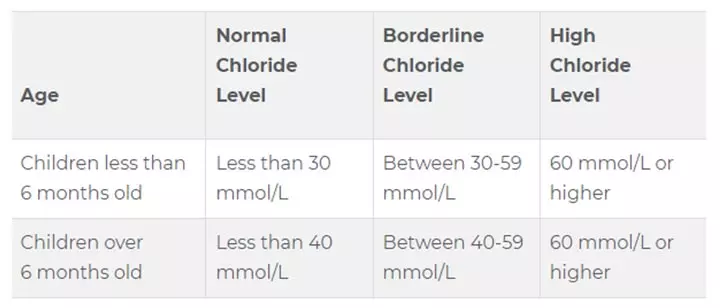
Source: Cincinnati Children’s
mmol/L: millimoles per liter
Most children with cystic fibrosis are diagnosed before the age of two; however, others with milder symptoms are not diagnosed until they reach adolescence (8) (9).
Treatment of Cystic fibrosis

Cystic fibrosis is a life-long disease, but healthcare providers advise effective disease management strategies. These are (8) (9):
- Physical exercises, breathing exercises, nebulizer treatments, and chest physical therapy help loosen and clear mucus from the lungs.
- Washing hands regularly, staying away from sick people, and taking preventive antibiotics help prevent lung infections.
- Supplemental pancreatic enzymes help digest food properly. Breastfeeding children need enzymes too.
- Eating a nutritious, high-calorie, and high-protein diet is recommended.
- Multivitamins and a plenty of salt through food could help too as patients are at a risk of salt wasting
 Things to know
Things to knowThalassemia
Thalassemia is a genetic blood disorder, inherited from parents, which causes the body to produce less hemoglobin
. This affects the body’s oxygen-carrying capacity. This condition is most common in Italy, Greece, the Middle East, Asia, and Africa (10).
Causes of thalassemia
Hemoglobin is made of two proteins: alpha-globin and beta-globin. Thalassemia occurs when there is a mutation in the gene or genes that produce these proteins.
The two main types of thalassemia are (11):
- Alpha thalassemia (gene or genes producing the alpha-globin are mutated)
- Beta thalassemia (gene or genes producing the beta-globin are mutated)
Symptoms of thalassemia
Since thalassemia affects the production of hemoglobin, many symptoms arise due to the lack of oxygen in the body from anemia.
Some mild to moderate symptoms are (10):
- Slow growth and development
- Fatigue
- Delay in reaching puberty
- Brittle bones
- Enlarged spleen
Severe symptoms of thalassemia are (10):
- Pale appearance
- Dark urine
- Loss of appetite
- Yellow tint of eyes or skin (jaundice)
- Problems with facial bones
- Enlarged heart, liver, and spleen
An anonymous mom shares her experience when her daughter was diagnosed with Thalassemia, “Avisha (the daughter) was growing up well, all was going well until she had started getting sick and we had to rush her to the hospital one day, home the other. Avisha had developed a mild fever and cold in the middle of summer, which was unusual. One day, the doctor advised Aryan (the husband) and me to visit a doctor in Gujarat. The doctor (Rudolph Simeone) had said that Avisha had Thalassemia. What?? I thought in the first place. I just couldn’t believe what I heard. I was scared. With the daily struggles Avisha faced, I finally agreed to check her up. She was still sick by the time we were in the hospital. The checkups were done, and the news was confirmed. She did have Thalassemia (ⅰ).’’
Diagnosis of thalassemia
Thalassemia can be diagnosed before or after birth.
- Since the disorder is inherited from parents, family genetic evaluation (blood test of family members and information about family medical history) may help diagnose it.
- After birth, certain hemoglobin tests and complete blood count help diagnose the condition. The blood of the affected children has smaller red blood cells. Most moderate to severe thalassemia conditions are diagnosed before the age of two (10).
Treatment of thalassemia
Children with mild thalassemia do not require any treatment. However, those with moderate to severe conditions require different treatments based on the severity.
- Blood transfusion
- Iron chelation therapy (removing extra iron from the body)
- Folic acid supplements
In rare cases, stem cell or bone marrow transplants may also help treat the disease.
In addition, a healthy lifestyle and regular follow-up help manage the condition effectively (10).
Huntington’s disease
Huntington’s disease in children (juvenile Huntington’s disease) is a genetic disorder that causes brain cells to break down at certain places. This gives rise to emotional problems, uncontrolled movements of hands, feet, and face, and intellectual disability in children.
Children usually inherit the gene mutation from their father, and sometimes, from their mothers. The disease is progressive, and children with juvenile Huntington’s disease do not survive for more than 10 to 15 years after the onset of symptoms (12).
Causes of Huntington’s disease
Juvenile Huntington’s disease is an autosomal dominant disorder because one copy of the defective gene is enough to cause the condition.
The disease is caused by the mutation in the HTT gene, which is responsible for making the huntingtin protein (a protein essential for nerve cells in the brain). Improper functioning of this protein causes the death of nerve cells in certain areas of the brain (12).
Symptoms of Huntington’s disease
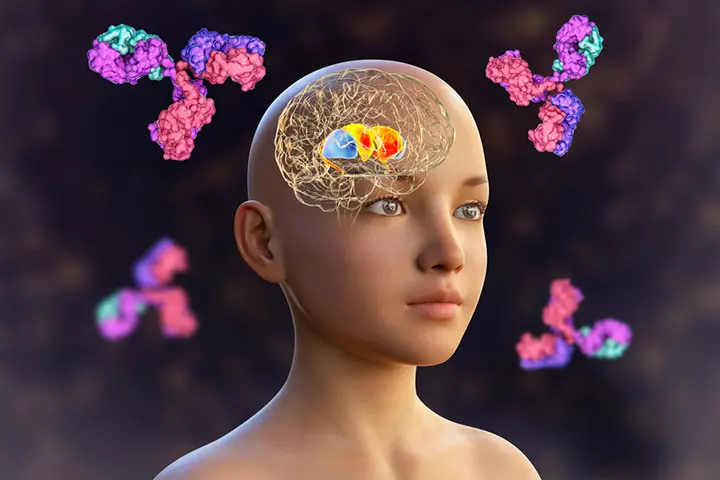
Once the symptoms of the disease show up, they usually worsen. Some of these symptoms are (12):
- Chorea (uncontrolled movements)
- Change in emotions
- Loss of thinking and reasoning abilities, leading to a decline in school performance
- Change in the personality
- Tremors and muscle twitching
- Stiff leg muscles
- Slowed (or slurred) speech
- Coordination problems
- Difficulty in swallowing
- Feeling of anger, sadness, and fear
- Seizures (uncontrolled electrical disturbance in the brain cells)
Diagnosis of Huntington’s disease
The disease is diagnosed by pediatric neurologists. They first perform a physical examination to check the symptoms. Then, they evaluate the family history to find out if any other member has the disease. Some tests that help diagnose the disease are (13):
- Blood tests
- Genetic testing
- Imaging tests (magnetic resonance imaging and computed tomography scan)
Treatment for Huntington’s disease
Currently, there is no treatment for the disorder. The treatment options available focus on relieving the symptoms and improving the quality of life. Since the disease affects children in several ways, a multidisciplinary treatment approach is followed. Some of these are (13):
- Physical therapy and counseling
- Genetic counseling
- Occupational therapy
- Drugs such as tetrabenazine and haloperidol control chorea.
- Antidepressants such as fluoxetine treat depression.
- Antipsychotic drugs such as olanzapine help relieve agitation and hallucinations.
Mood-stabilizing drugs such as lithium can reduce anxiety and mood swings.
Tay-Sachs Disease
Tay-Sachs disease is a genetic disorder that affects the brain and spinal cord of a child. The condition occurs when a gene for Tay-Sachs disease is inherited from both of the parents. This means both parents need to be carriers of Tay-Sachs disease for it to manifest in their children. Children with this disease usually die by age four from complications of pneumonia (14).
Causes of Tay-Sachs disease
Children with Tay-Sachs disease lack an enzyme called hexosaminidase A, a protein that causes chemical reactions in cells. As a result, fatty substances begin to collect due to the lack of this enzyme and lead to Tay-Sachs symptoms, such as muscle weakness (14).
Symptoms of Tay-Sachs disease
The symptoms become noticeable when children are around three months old. These symptoms progress with age, and children start to lose their ability to reach their developmental milestones. The symptoms for Tay-Sachs disease at different stages are (14):
At around three to six months
- Increase in surprised response
- Low muscle tone and muscle weakness
- Myoclonic jerks when falling asleep (sudden involuntary muscle jerk)
At around six to ten months
- Decrease in eye movement and eye contact
- Inattentiveness
- Losing the ability to sit
- Not reaching developmental milestones
- Red spot in the eye
At around eight to ten months
- Decreased movement and response
- Loss of vision
- Beginning of seizures
Diagnosis of Tay-Sachs disease
- Healthcare providers diagnose the disease through a blood test. If the level of hexosaminidase A is completely nil, it indicates Tay-Sachs disease.
- Eye exam to check the red spot in the eye (14).
Treatment for Tay-Sachs disease
There is no treatment for this disease. Medications may be given to children to help reduce seizures. Affected children should also be provided proper nutrition and hydration (14).
 Point to consider
Point to considerCleft lip and palate
The cleft lip and palate is an abnormal opening, or cleft, in babies’ upper lip or palate when they are born. This cleft can be small or large and happens when babies’ palates are not formed properly early in pregnancy.
For some, it may not be noticeable since it is inside the mouth, and for others, the opening might lead to the nasal cavity and not be noticeable from the outside (15).
Causes of cleft lip and palate
A child’s skin and bone of the upper jaw, nose, and mouth fuse to form the lip and palate during six to ten weeks of pregnancy. If the formation does not occur properly, it may lead to a cleft in the lip or palate.
Researchers are not sure what affects the formation of cleft lip and palate in some children. It may be related to some genetic and environmental factors. The environmental factors that increase the risk of this congenital disorder are (15) (16):
- Intake of certain medications during pregnancy
- Inadequate vitamin B and folic acid during pregnancy
- Exposure to certain chemicals during pregnancy
- Smoking, consuming alcohol, and illicit drug intake during pregnancy
- Family history (parents with a cleft lip or palate)
Symptoms of cleft lip and palate
The symptoms of cleft lip and palate in children are (15) (16):
- Lip is not completely closed.
- Roof of the mouth (palate) is not completely closed.
- Both lip and palate are not completely closed.
Children with cleft lip and palate may experience complications such as:
- Difficulty in feeding
- Speech problems
- Ear infections and loss of hearing
- Dental problems
Diagnosis of cleft lip and palate

A cleft lip or palate can be diagnosed through a routine ultrasound test during pregnancy or the baby’s first physical examination after birth (15) (16).
Treatment of cleft lip and palate
A cleft lip and palate can be corrected with the help of a surgery called cheiloplasty (15) (16).
- Lip cleft may be corrected when the child is around three to six months.
- Palate cleft may be corrected when the child is around 10 to 14 months.
Turner syndrome
Turner syndrome is a congenital genetic disorder that affects only females. It happens in around one out of 2500 females worldwide. Affected individuals are short in height and have problems with periods and breast development (17).
Causes of Turner syndrome
Turner syndrome is an inherited disease where one of the parents passes a defective gene (mutated gene) to the offspring. In a female child affected by this chromosomal disorder, one of the two X chromosomes is incomplete or missing (17).
Symptoms of Turner syndrome
Most females with this condition are short, with an average height of around four feet eight inches. The other symptoms are (17):
- Improper breast development
- Absence of menstruation
- Small ovary with functional impairment
- No puberty
- Absence of sex hormones
- Broad chest
- Dental problems
- Eye problems
- Scoliosis (spine curved towards the side)
- Several moles on the skin
- Narrow nails of fingers and toes
- Small lower jaw
- Swollen hands and feet
- Short and wide neck with extra skin folds
- Developmental delays (clumsiness, problems with memory, attention, planning, and management)
Diagnosis of Turner syndrome
- Parents can detect the condition by looking at the physical symptoms of their children, such as swollen hands and feet, webbed neck, and inadequate growth.
- A genetic test called the karyotype analysis is used to confirm the presence of the condition. It uses a blood sample of the affected child to examine the X chromosomes.
- Complete heart evaluation since people with this syndrome have heart problems (17).
Turner syndrome may be diagnosed before the birth of a child through the following tests (17):
- Maternal serum screening (blood of the mother shows chromosomal problems)
- Amniocentesis and chorionic villus sampling (checks amniotic fluid and tissue from the placenta, respectively)
- Ultrasound
Treatment of Turner syndrome
The treatment of the condition depends on the problems children are experiencing. Some common treatment options are (17):
- Human growth hormone injections to increase the height of children.
- Estrogen therapy (female hormone) helps in the development of breasts and the initiation of menstruation.
- Cyclic progestins given at the age of 10 or 12 stimulate puberty.
Muscular dystrophy
Muscular dystrophy is characterized by mild to severe muscle weakness that might start at different ages in children. The two types of muscular dystrophies are Duchenne muscular dystrophyiAn inherited muscular disorder resulting from genetic change, leading to weak muscles (especially in the legs) and Becker muscular dystrophyiA progressive genetic disorder leading to the weakening of muscles particularly affecting the legs, heart, and pelvic muscles (18). Duchenne muscular dystrophy is the most common type of muscular dystrophy that is diagnosed during childhood (19). The Muscular Dystrophy Association reports that about one in 5000 live male births, or around 20,000 children, are diagnosed with DMD each year, globally.
Causes of muscular dystrophy
Muscular dystrophy is passed down from parents to children. The genetic variation prevents the body from making proteins required for healthy muscles (18).
Symptoms of muscular dystrophy
Some symptoms of this condition are (18):
- Clumsiness
- Trouble in climbing stairs
- Leg pain
- Weak muscles of arms, legs, and face
- Large calves
Since the symptoms of this condition are progressive, they can develop into the curved spine, heart and breathing problems, and walking issues.
Diagnosis of muscular dystrophy
Muscular dystrophies are diagnosed by (18):
- Understanding family history
- Doing physical examinations
- Blood test and genetic testing
- Muscle biopsy
- Electromyography to check whether nerves and muscles are working together
- Echocardiogram to check the heart
Treatment of muscular dystrophy

There is no cure for muscular dystrophy, but effective treatment strategies may help children stay active and independent. The treatment options are chosen based on the type and severity of the condition. Some of these options are (18):
- Physical therapies
- Support with wheelchairs and walkers
- Using braces and splints
- Medications
- Breathing support
- Scoliosis surgery
- Nutritional counseling
Sickle cell anemia
Sickle cell anemia is a blood disorder where the red blood cells change their shapes from round discs to the crescent moon (sickle-shaped). These sickle-shaped red blood cells get stuck in the blood vessels and block them, leading to an obstruction in the blood flow that causes pain and organ damage (20).
Causes of sickle cell anemia
Sickle cell anemia is inherited from parents (heredity). If the hemoglobin gene passed from the parents to children is defective (mutated), it will lead to the formation of defective red blood cells.
The types of gene inheritance are (20):
- If each parent passes one mutated gene, the child has sickle cell anemia.
- If one parent passes a mutated gene while the other parent passes a normal gene, the child is a carrier but does not have the disease.
- If one parent passes a mutated gene for sickle cell anemia, while the other parent passes a mutated gene for some other condition, the child may develop another disorder.
Symptoms of sickle cell anemia
Some symptoms of sickle cell anemia in children are (20):
- Pain in any part of the body that may last for a few hours to a few days
- Cold, stress, or illness may also cause pain
- Pale appearance
- Fatigue and dizziness
- Shortness of breath
- Irritable and inability to pay attention
- Increased heart rate
- May have jaundice if red blood cells break down faster than they are formed
Other complications of the condition are (20):
- Infection and inflammation in lungs, causing chest pain and cough
- Severe anemia
- Swelling in fingers and toes
- Risk of bacterial infections
- Enlarged spleen traps red blood cells
- Stroke
Diagnosis of sickle cell anemia
Sickle cell anemia
is diagnosed soon after birth through regular newborn screening tests. This test is further confirmed by another blood test called hemoglobin electrophoresis.
The condition can also be diagnosed during pregnancy through amniotic fluid or placenta testing (a sample of placenta tissue is tested) (20).
Treatment of sickle cell anemia
Some treatment options that are still in the nascent stage are (20):
- Stem cell transplant (suitable only for some patients)
- Genetic therapy or gene therapy (research is ongoing)
Other treatment options that help children manage their condition are (20):
- Immunizations and administration of penicillin to help prevent infections.
- Folic acid supplements help in the formation of new red blood cells.
- An everyday dosage of a medication called hydroxyurea helps make cells less sticky, thus preventing blockages in the blood vessels.
- Pain-management medications
- Blood transfusions in case of severe anemia.
Klinefelter syndrome
Klinefelter syndrome is a genetic disorder characterized by an extra X chromosome in males, resulting in a chromosomal pattern of XXY instead of the usual XY. Klinefelter syndrome is relatively common, affecting approximately 1 in 600 individuals assigned male at birth (AMAB) (21).
Causes of Klinefelter syndrome
It is caused by an extra X chromosome in the offspring. Advanced maternal age may also slightly increase the risk of the syndrome (22).
Symptoms of Klinefelter syndrome
The signs of this condition may vary from person to person (23):
- Taller than average (2 to 3 inches taller than family average)
- Small testes producing reduced testosterone
- Delayed or incomplete puberty
- Gynecomastia (breast enlargement)
- Decreased muscle mass, bone density, facial, and body hair
- Fatigue
- Infertility (but assisted reproductive technologies may help)
- Curved pinky fingers (fifth finger clinodactyly)
- Flat feet (pes planus)
- Less commonly, abnormal fusion of certain forearm bones (radioulnar synostosis)
- Low muscle tone (hypotonia)
- Difficulty coordinating movements
- Mild delays in developmental skills
- Impaired social skills
- Emotional immaturity during childhood
Diagnosis of Klinefelter syndrome
Diagnosis involves a physical examination, reproductive hormone level checks through blood samples, and confirmation via checking for the presence of the extra X chromosome (22).
Treatment of Klinefelter Syndrome
- Testosterone replacement therapy (TRT), and other supportive therapies include speech and language therapy, educational support, occupational therapy, physiotherapy, and psychological support.
- Lifestyle changes and a healthy diet can contribute to overall well-being (22).
Frequently Asked Questions
1. Is autism a genetic disorder?
Scientists consider that genetic factors contribute to 40% to 80% of the risk of autism. Fragile X syndrome and Rett syndrome have been found to cause autism spectrum disorder. Rare gene mutations or chromosomal abnormalities are thought to cause 2% to 4% of the condition. Examples are rare mutations in genes such as ADNP, ARID1B, POGZ, ASH1L, CHD8, CHD2, DYRK1A, SYNGAP1, and SHANK3 (24) (25).
2. Is anxiety a genetic disorder?
Hereditary factors have been considered responsible for about 30% to 67% of anxiety disorders. No single gene is responsible, but a number of genetic interactions may make one vulnerable to developing anxiety disorders. Further, our environment (food, sleep, stress levels) may alter gene expression (26) (27).
3. Is depression genetically inherited?
About 10% of the US population is thought to encounter depression at some point in their lives. However, someone with a family history of major depression has probably two or three times greater risk of developing the disorder. Depression is not found to be inherited due to any single genetic defect, but a person may inherit a unique combination of genes from their parents that may make them more susceptible to depression (28).
4. Is ADHD genetically inherited?
Research shows that parents and siblings of a person with ADHD have greater chances of getting the condition (29). Studies also found that nearly one-third of fathers who have had or have ADHD will have children diagnosed with the same condition due to possible genetic inheritance (30).
5. Does a child need genetic testing?
Genetic testing becomes important if the child belongs to a family with genetic illnesses in close relatives (31). It provides more information about the long-term healthcare needs of the child and future family planning. Genetic testing should also be done if the child shows symptoms of a condition linked with a genetic disorder, such as intellectual disabilities, developmental delays, congenital anatomical disabilities, and movement disorders (32).
6. What is genetic counseling?
Genetic counseling is a service where trained professionals, called genetic counselors, help individuals or families understand genetic disorders. They analyze family history and explain how a genetic condition could affect a person or their family. They also review genetic test results to estimate disease risks. These professionals can help individuals make informed health choices and provide emotional support to help them handle their condition.
Infographic: What Are Some Common Genetic Conditions In Children?
Genetic disorders can affect a child’s physical and cognitive development and may lead to social and behavioral challenges. However, early diagnosis and intervention can help the children with their daily lives and handle the symptoms. Check out the infographic below to learn about some common genetic disorders observed in children.
Some thing wrong with infographic shortcode. please verify shortcode syntaxVarious types of genetic disorders in children could be inherited from one or both parents. Some of these disorders are treatable, while others may not be curable but have to be managed by prompt evaluation, medications, tailored therapies, and specific lifestyle modifications. Consequently, if you suspect that your child may have any genetic abnormalities, it is vital to discuss your concerns with a pediatric specialist. This will enable you to develop appropriate treatment strategies. Addressing your child’s ailment early can help manage their condition effectively and improve their quality of life.
Illustration: Genetic Disorders In Children: Symptoms And Treatment

Image: Dalle E/MomJunction Design Team
Personal Experience: Source
MomJunction articles include first-hand experiences to provide you with better insights through real-life narratives. Here are the sources of personal accounts referenced in this article.
ⅰ. Thalassemia Chapter 2.https://medium.com/@devdevsomani10/thalassemia-chapter-2-db3262a5747d
References
- Genes and Genetics.
https://kidshealth.org/en/teens/genes-genetic-disorders.html - Genetic conditions.
https://www.healthywa.wa.gov.au/Articles/F_I/Genetic-conditions - Facts about Down Syndrome.
https://www.cdc.gov/ncbddd/birthdefects/downsyndrome.html - What are common symptoms of Down Syndrome?
https://www.nichd.nih.gov/health/topics/down/conditioninfo/symptoms - How do health care providers diagnose Down syndrome?
https://www.nichd.nih.gov/health/topics/down/conditioninfo/diagnosis - What are common treatments for Down syndrome?
https://www.nichd.nih.gov/health/topics/down/conditioninfo/treatments - About Fragile X Syndrome.
https://www.cdc.gov/fragile-x-syndrome/about/ - Cystic Fibrosis in Children.
https://www.cincinnatichildrens.org/health/c/cystic-fibrosis - Cystic Fibrosis.
https://kidshealth.org/en/parents/cf.html - What is thalassemia?
https://www.childrensmn.org/services/care-specialties-departments/cancer-blood-disorders/conditions-and-services/blood-disorders-services/hemoglobinopathy-sickle-cell/thalassemia/ - Thalassemia.
https://medlineplus.gov/ency/article/000587.htm - Juvenile Huntington Disease.
https://rarediseases.info.nih.gov/diseases/10510/juvenile-huntington-disease/ - Huntington’s Disease.
https://my.clevelandclinic.org/health/diseases/14369-huntingtons-disease - Tay-Sachs Disease.
https://my.clevelandclinic.org/health/diseases/14348-tay-sachs-disease - Cleft Lip and Palate.
https://www.stlouischildrens.org/conditions-treatments/cleft-lip-and-palate - Cleft Lip.
https://kidshealth.org/en/parents/cleft-lip.html - Turner Syndrome.
https://my.clevelandclinic.org/health/diseases/15200-turner-syndrome - Dystrophy.
https://kidshealth.org/en/parents/muscular-dystrophy.html - Types of Muscular Dystrophy.
https://nyulangone.org/conditions/muscular-dystrophy/types#:~:text=Duchenne%20muscular%20dystrophy%20is%20the,need%20a%20respirator%20to%20breathe. - Sickle Cell Disease.
https://kidshealth.org/en/parents/sickle-cell-anemia.html - Autism spectrum disorder.
https://medlineplus.gov/genetics/condition/autism-spectrum-disorder/#causes - Klinefelter Syndrome.
https://my.clevelandclinic.org/health/diseases/21116-klinefelter-syndrome - Klinefelter syndrome.
https://www.nhs.uk/conditions/klinefelters-syndrome/#:~:text=Klinefelter%20syndrome%20(sometimes%20called%20Klinefelter’sgenetic%20sex%20of%20a%20baby. - Klinefelter syndrome.
https://medlineplus.gov/genetics/condition/klinefelter-syndrome/#causes - Genetic disorders.
https://www.cdc.gov/genomics-and-health/about/genetic-disorders.html - Katharina Domschke and Eduard Maron; (2013); Genetic factors in anxiety disorders.
https://pubmed.ncbi.nlm.nih.gov/25225016/ - Does Anxiety Run in Families?
https://healthtalk.unchealthcare.org/does-anxiety-run-in-families/ - Major Depression and Genetics.
https://med.stanford.edu/depressiongenetics/mddandgenes.html - Attention deficit hyperactivity disorder (ADHD).
https://www.nhs.uk/conditions/attention-deficit-hyperactivity-disorder-adhd/causes/#:~:text=Genetics,likely%20to%20have%20ADHD%20themselves. - About Attention Deficit Hyperactivity Disorder.
https://www.genome.gov/Genetic-Disorders/Attention-Deficit-Hyperactivity-Disorder - Genetic Testing.
https://kidshealth.org/en/parents/genetics.html - What parent’s need to know about genetic testing.
https://www.nationwidechildrens.org/family-resources-education/700childrens/2025/02/genetic-testing - Genetic Disorders
https://my.clevelandclinic.org/health/diseases/21751-genetic-disorders
Community Experiences
Join the conversation and become a part of our nurturing community! Share your stories, experiences, and insights to connect with fellow parents.
Read full bio of Dr. Jessica Madden
Read full bio of Pragya Bhargavi
Read full bio of Dr. Ritika Shah
Read full bio of Dr. Joyani Das








